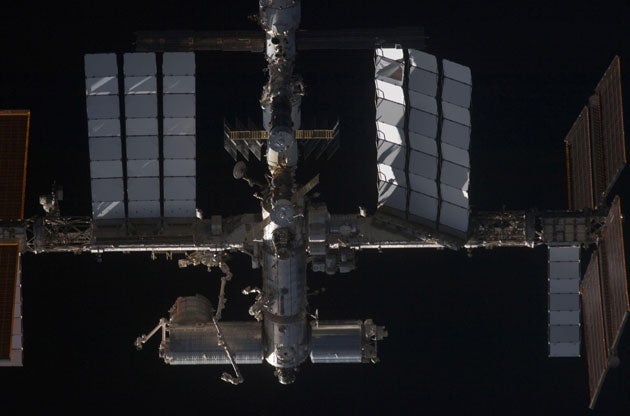Your support helps us to tell the story
From reproductive rights to climate change to Big Tech, The Independent is on the ground when the story is developing. Whether it's investigating the financials of Elon Musk's pro-Trump PAC or producing our latest documentary, 'The A Word', which shines a light on the American women fighting for reproductive rights, we know how important it is to parse out the facts from the messaging.
At such a critical moment in US history, we need reporters on the ground. Your donation allows us to keep sending journalists to speak to both sides of the story.
The Independent is trusted by Americans across the entire political spectrum. And unlike many other quality news outlets, we choose not to lock Americans out of our reporting and analysis with paywalls. We believe quality journalism should be available to everyone, paid for by those who can afford it.
Your support makes all the difference.After eight days together, space shuttle Discovery pulled away from the international space station on Wednesday, ending a successful effort to boost electrical power and science research at the orbiting outpost.
Nasa was thrilled to see the space station with its new glistening pair of solar wings - the final ones. The shuttle took a victory lap around the station, primarily for picture-taking, and then put itself on a course for a Saturday touchdown.
"The $100 billion photograph," flight director Kwatsi Alibaruho said, showing off one of the snapshots. He noted that was the space station price tag cited by senators during President Barack Obama's call to the astronauts the day before. Nasa disputes that amount, "so that's a little joke we've got in Mission Control," he said.
With the installation last week of the last set of solar wings, the space station finally resembles the artist renderings from years past, balanced with four wings on both sides.
"You always saw it in the pictures and you just wondered if you're really ever going to get there," said Dan Hartman, a space station manager. He took "an extreme amount of pride and joy" in seeing the images beamed down.
Nasa expects the extra electrical power to drastically increase the amount of research in the various labs that make up the 220-mile-high outpost.
"You made the space station much better than it was before," Fincke told the shuttle astronauts just before their departure. "You gave us more power, symmetry - which is not to be underrated - and you gave us a new crew member."
That new member, Japanese astronaut Koichi Wakata, remained behind on the space station with Fincke and a Russian cosmonaut.
Sandra Magnus, whom Wakata replaced, kept waving as she disappeared down the hatch and floated into Discovery. Wednesday marked her 131st day in space; she moved into the space station in mid-November.
"All of you guys, this is the toughest part of the mission, at least for me," Fincke said. "On one hand, it's a moment of triumph ... and yet on the other hand, we're going to really be missing you."
The two crews embraced as they said goodbye and closed the hatches. The actual undocking occurred a few hours later, as the spacecraft soared over the Indian Ocean.
"Godspeed," called out Fincke. He added: "Come again."
Fincke and his crew will be getting company again in just a few days. A Russian Soyuz rocket is set to lift off on Thursday with two new station crewmates and a billionaire tourist along for the ride; they'll arrive this weekend. Fincke then will return to Earth with Microsoft Word and Excel developer Charles Simonyi and cosmonaut Yuri Lonchakov.
Discovery is bringing back five months of experiments from the space station. The 80 to 90 vials of blood, urine and saliva samples were stuffed into the shuttle freezer or wrapped in ice packs.
Discovery also is returning four to five litres of recycled water made from the astronauts' urine and sweat. Nasa wants to make sure the water is safe before space station astronauts start drinking it there; test results are expected in about a month.
The reclaimed water is an essential part of Nasa's plan to double the size of the space station crew, to six, in just another two months.
Discovery supplied the space station with a new urine processor to replace the original one, which malfunctioned.

Join our commenting forum
Join thought-provoking conversations, follow other Independent readers and see their replies
Comments